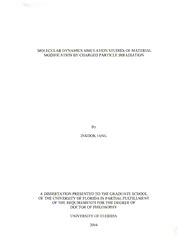Table Of ContentMOLECULARDYNAMICSSIMULATIONSTUDIESOFMATERIAL
MODIFICATIONBYCHARGEDPARTICLEIRRADIATION
By
INKOOKJANG
ADISSERTATIONPRESENTEDTOTHEGRADUATESCHOOL
OFTHEUNIVERSITYOFFLORIDAINPARTIALFULFILLMENT
OFTHEREQUIREMENTSFORTHEDEGREEOF
DOCTOROFPHILOSOPHY
UNIVERSITYOFFLORIDA
2004
Copyright2004
by
InkookJang
ACKNOWLEDGMENTS
First,Iwouldliketoshowmysinceregratitudetomyadvisor,Dr.SusanB.Sinnott,
forherconstantguidanceandencouragement.Hersupportandinstanthelpthroughout
mygraduatecareerlaidasmoothwayformystudiesandresearchwork,andenabledme
toachievemygoal.IamalsogreatlythankfultoallthemembersinDr.Sinnott’s
researchgroupforacademicdiscussionandcheerfultalks.
Finally,Iwishtoexpressmygreatappreciationtomybelovedparents.
hi
TABLEOFCONTENTS
page
ACKNOWLEDGMENTS
iii
LISTOFTABLES vi
LISTOFFIGURES vii
ABSTRACT
ix
CHAPTER
GENERALINTRODUCTION
1 1
1.1MolecularSimulations 1
1.2MolecularDynamicsMethod 5
1.3PlasmaProcessing 7
1.3.1PlasmaModificationofPolymer 8
1.3.2FluorocarbonPlasma 8
1.3.3PolyatomicIonDeposition 9
1.4CarbonNanotubesJunctions 10
1.4.1CarbonNanotubes 10
1.4.2JoiningofCarbonNanotube 14
2 SIMULATIONMETHODS 16
2.1TheReactiveEmpiricalBondOrderPotential 16
2.2C-H-FPotential 19
2.3TheLennard-JonesPotential 23
2.4PeriodicBoundaryConditions 24
2.5Predictor-CorrectorAlgorithms 25
2.6TemperatureControlMethods 26
2.7TightBindingMethods 28
3 POLYATOMICIONBEAMDEPOSITIONONPOLYMERSURFACES 29
3.1SimulationDetails 31
3.1.1ContinuousFluorocarbonIonDepositiononPSSurface 32
3.1.2HydrocarbonIonDepositiononPSandPEsurfaces 34
3.2ResultsandDiscussion 34
IV
3.2.1ContinuousFluorocarbonIonDepositiononPS 34
3.3 3.2.2AngularInfluenceofCbHs^IonDepositiononPSSurface 52
3.2.3Polystyrenevs.Polyethylene 59
Conclusions 67
3.3.1ContinuousFluorocarbonIonDepositiononPS 67
3.3.2AngularInfluenceofCsHj^IonDepositiononPSSurface 68
3.3.3Polystyrenevs.Polyethylene 68
4 CARBONNANOTUBEWELDINGUNDERELECTRONBEAMIRRADIATION
70
4.1SimulationDetails 70
4.2ResultsandDiscussion 75
4.3Conclusions 86
5 GENERALCONCLUSIONS 88
LISTOFREFERENCES 91
BIOGRAPHICALSKETCH 101
V
LISTOFTABLES
Table page
22--1. Two-bodyparametersusedinequation(2-2),(2-3),(2-4),and(2-6) 20
32--2. ValuesofPfromequation(2-13)attheintegerpointsusedforcubicspline
interpolation 21
2-3. AtomizationenergiesofvariousmoleculescalculatedbynewC-H-Fpotentialand
semi-empirical(PM3)method 22
4. Lennard-Jonesparameters 23
1. Surfacedensityofindicatedspeciesthatremainbondedtocarbonatomsin,orare
embeddedwithin,thePSsurfacesafterCsFj^deposition 38
3-2. Surfacedensityofindicatedspeciesthatremainbondedtocarbonatomsin,orare
3- embeddedwithin,thePSsurfacesafterCFa"^deposition 38
43--3. YieldofscatteringspeciesforCFa"^deposition 41
3-4. YieldofscatteringspeciesforCaFs"^deposition 41
3-5. Surfacedensityofindicatedspeciesthatremainbondedtocarbonatomsin,orare
embeddedwithin,thePSsurfacesafter105CsFs"^depositionat100eV/ion 51
3-6. Surfacedensityofindicatedspeciesthatremainbondedtocarbonatomsin,orare
embeddedwithin,thePSsurfacesafter105CsFs"^depositionat50eV/ion 51
3-7. Percentageofoccurrenceoftheindicatedeventsaveragedover80trajectoriesat
differentincidentangles 53
8. PercentageofoccurrenceoftheindicatedeventsintheMDsimulationsof
depositionaveragedover80trajectories 60
1. ThedimensionsofeachCNTpairandirradiationarea 74
4-2. SummaryofbondingatthejunctionsformedbetweenthefollowingpairsofCNTs
byelectronbeamirradiationasdescribedinthetext 79
VI
1- LISTOFFIGURES
2-
Figure page
2-
31--1. TheschemetodetermineBravaisvector 11
2. Structuremodelsofcarbonnanotubes 12
1. Schematicrepresentationofperiodicboundarycondition 24
2. Schematicdiagramoftypicalheatbathapplication 27
1. Modelsof(a)PSand(b)PEchains 31
3-2. SchematicrepresentationofinitialPSsubstrate 33
3-3. StructuremodelsofPSsurfacesanddepthprofileofFdensityafterionbeam
depositionat50eV/ion 35
3-4. SnapshotformtheMDsimulationsthatshowsaCF2fragmentlinkingtwoPS
chains 40
3-5. FuptakeandtotaldepositionyieldofFasfunctionoffluenceduringdeposition..42
3-6. DegreeofPSsurfaceetchingduringionbeamdeposition 44
3-7. AveragepenetrationdepthsofindicatedspeciesinthePSsurfaces 46
3-8. AportionofthePSstructureafterdepositionof240CaFs"^ions 47
3-9. StructuremodelsofpartofthePSsurfacesafter105CsFs"^iondepositionat50
eV/ionand100eV/ion 48
3-10.StructuremodelsofPSsurfacesanddepthprofilesofFdensityafter105CsFs”^ion
deposition 49
3-11.Percentagesoftheindicatedproductspeciesthatremainbondedtocarbonatomsin
thePSsurfaceorareembeddedinthePSsurface 55
3-12.SnapshotfromtheMDsimulationsshowingtheproductsofthedissociationofthe
ionintoCH2fragmentsthatbondtothePSsurface 57
vii
3-13.AveragenumberofbrokenbondspertrajectoryinthePSsurfaceasaresultof
depositionattheindicatedanglesoverthe80trajectories 58
3-14.Averagepenetrationdepthsofmajorspecies(C3H5,CaHn,CH2)fromtheincident
ionsasafunctionofangle 59
33--15.Percentagesoftheindicatedproductspeciesthatremainbondedtocarbonatomsin,
orareembeddedwithin,thePSandPEsurfacesat50and25eV 63
4-
3-16.AveragenumberofbrokenbondsinthePSandPEsurfacesperMDtrajectoryasa
resultofCaffs'^depositionat50and25eV 65
17.Averagepenetrationdepthsofmajorspecies(C3H5,C2Hn,CH2)fromtheincident
ions 67
1. Initialconfigurationofcrossednanotubesforelectronbeamirradiation 72
4-2. FinalstructureofeachCNTpairafterelectronbeamirradiationandannealing 76
4-3. Structuremodelsof(a)ideal(5,5)-(5,5)CNTjunctionand(b)hydrogenterminated
(5,5)-(5,5)CNTjunction 80
4-4. ThechangeinenergyasafunctionofstrainduringthedeformationofweldedCNT
pairsafterannealing 81
4-5. DOS(fullcurve)andeigenvalueparticipationratio(histogram)aroundtheFermi
level(shiftedat£=0)forideal(5,5)-(5,5)CNTjunction 83
4-6. DOSandeigenvalueparticipationratioaroundtheFermilevelfor(5,5)-(5,5)CNT
junctionproducedbyelectronbeamirradiation 84
4-7. Plotofthelongitudinaldistributionoftheelectronprobabilitydensityforthefirst
feweigenvalues(«=0,...8)abovetheFermilevel(«=0)ofthe(5,5)-(5,5)CNT
junctionproducedbyelectronbeamirradiation 85
viii
AbstractofDissertationPresentedtotheGraduateSchool
oftheUniversityofFloridainPartialFulfillmentofthe
RequirementsfortheDegreeofDoctorofPhilosophy
MOLECULARDYNAMICSSIMULATIONSTUDIESOFMATERIAL
MODIFICATIONBYCHARGEDPARTICLEIRRADIATION
By
InkookJang
May2004
Chair: SusanB.Sinnott
MajorDepartment: MaterialsScienceandEngineering
Chargedparticleirradiationprocesses,suchasionbeamdepositionandelectron
beamirradiationareoftenusedtomodifythepropertiesofvariousmaterials.However,
detailedreactionmechanismsthatleadtostructuralchangesinthesubstratesaredifficult
todetermineexperimentally,asprimarilyindirectinformationisobtainedusing
experimentalmethods.Computersimulationmethodsarecomplementarytoexperimental
approachesandareabletoprovideinsightintothewayinwhichthesystemreachesits
finalstate.
Inthesestudies,moleculardynamicssimulationsareusedtoinvestigatepolyatomic
ionbeamdepositiononpolymersurfacesandcarbonnanotubeweldingunderelectron
beamirradiation.Theinteratomicforcesinthesimulationsaredeterminedusingthe
reactiveempiricalbondorderpotentialforshort-rangedcovalentinteractionsandthe
Lennard-Jonespotentialforlong-rangevanderWaalsinteractions.Forhydrocarbonion
deposition,someinclinedanglesarefoundtobemoreefficientforthedepositionofthe
IX
precursorsnecessaryforpolymerthin-filmgrowththannormalincidencedeposition.
Also,incidentenergiesof50eV/ionarepredictedtobemoreefficientthan25eV/ion,
andpolystyrene(PS)substratesfacilitatethegrowthofhydrocarbonthinfilmsmorethan
doespolyethylene.
Instudiesoffluorocarboniondeposition,thesimulationsshowhowandwhy
and playdifferentrolesinlow-energyplasmadepositionprocessesonPS.CFs"^
ionsdissociatemorereadilyonimpactandthelargenumberofFatomsthatareproduced
formcovalentbondswiththePSchains,whichbothefficientlyfluorinatesthePSand
slowsdownthinfilmgrowth.Incontrast,CsFs^ionsproducemorefluorocarbonpolymer
filmprecursorsthatenhancethinfilmgrowth,whileatthesametimefluorinatingthe
surfaceataslowerrate.
Inthestudyofcarbonnanotubewelding,thestructureofthegeneratedjunctionsis
characterizedbyalargedegreeofbondingdisorderthatleadstolowerstrengthand
higherductilitythanthosecharacterizing“ideal”junctions.Thegeneratedjunctionsalso
operateasquantumdots,incontrasttotheohmicbehaviorofidealjunctions.
X

